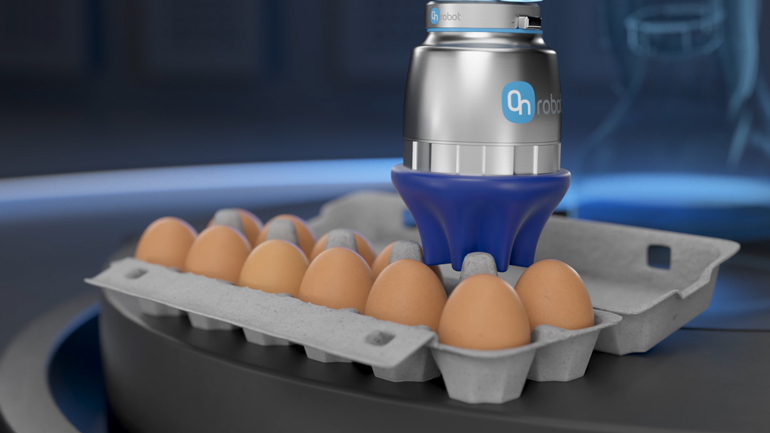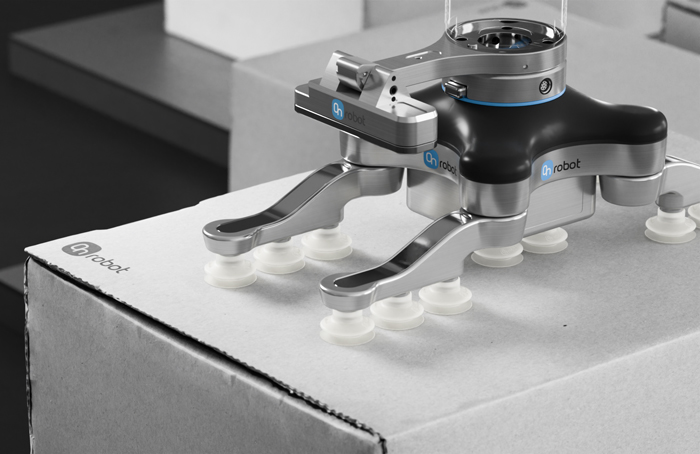Robotic Grippers Help Automate the Food Industry
27.05.2020
By leveraging new robotic gripper technology, the food and beverage industry can keep up with a growing demand.
The current world population is estimated to be 7.8 billion, and with the United Nations predicting that number will reach 10.9 billion by the end of this century, the need for food manufacturers to embrace automation in order to keep pace with demand is urgent and growing.
Demographics is just one driver of automation adoption in the food sector, however. Worker safety, stringent food safety regulations, a rise in the popularity of processed foods and the need to improve output while reducing production costs all play a part in increased automation adoption.
Until recently, food processing was something of a final frontier for robots.
Traditional automation excels in automotive manufacturing scenarios where metal meets metal, leather and plastic. But traditional automation struggles to cope with some of the unique demands of the food sector, where product often requires a soft touch, regularly arrives in irregular shapes or orientations and is destined for human consumption.
While traditional robotics systems have successfully served the food sector for many years in palletizing (and some packaging) applications, it is only in recent years that it has become possible for robots to handle delicate food items directly.
The arrival of new and improved gripper technology accompanied by vision systems changed everything. Advancements in gripper technology that mimic human touch made it possible for robots to pack fruits and vegetables.
Vacuum grippers enable robots to successfully perform packaging tasks with a delicacy that is beyond the capabilities of traditional grippers, and soft grippers enable the direct handling of foods in a way that ensures product is not damaged or bruised during the automation process.
As a result, secondary food processing applications are well within the abilities of automation systems. From picking and placing of soft fruits to handling chocolates and bakery items, the food sector is embracing new gripper technologies at a remarkable pace.
A recent report from ING found that the number of food manufacturers adopting automation increased by 50% between 2014 and 2019. The Association for Packaging and Processing Technologies also predicted the global food packaging market will grow at a CAGR of 4 to 5% to reach $400 billion by 2025.
So, what are the benefits of automation in the food sector, and what are the issues manufacturers need to keep in mind when selecting a gripper for food-related applications?

Worker Safety & Retention
With food manufacturers and workers facing challenges related to COVID-19, including new hygiene and social distancing regulations, it is a good time to consider supplementing the human workforce with automation. Robots can step in to fill those roles that are no longer safe or feasible for humans—plus robots can operate continuously.
Additionally, the arrival of collaborative robots provides manufacturers with a way to tackle the long-standing issue of worker retention. Collaborative robots allow production managers to reassign workers to more interesting tasks, while the robots take over the dull and dirty jobs—from heavy lifting to repetitive pick and place operations—that can lead to worker dissatisfaction and injury. Robots can help support social distancing requirements, ultimately leading to enhanced workplace safety and improved worker satisfaction.
Meet Stringent Food Safety Regulations
Driven by consumer and sector demand, regulatory bodies around the world enforce strict requirements on the food processing sector. Even with the best of intentions, human workers can carry and spread contaminants that end up finding their way into the final product.
With regulatory requirements in mind, it is essential that manufacturers choose certified food-grade grippers. In the U.S., look for FDA 21 CFR certification for non-fatty food items, and in Europe, make sure the gripper has EC 1935/2004 certification for food handling.
Certified soft grippers are recommended for processing of delicate, easily bruised items. They enhance food safety and are capable of handling a wide array of irregularly shaped and delicate foods such as lettuce, herbs and strawberries.
Ideally, choose a gripper that does not require an external air supply. Doing so will eliminate problems associated with dust and noise, in addition to reducing both complexity and cost.

Improve Productivity & Quality
Certified grippers can help manufacturers maintain high-quality standards—and avoid costly product recalls—while simultaneously helping to improve productivity.
Make sure that robotic grippers can handle payloads that meet (and even exceed) application requirements in most food processing scenarios. This means a gripper with a payload of up to 2.2 kg (4.85 lb).
Look out for grippers that are easy to swap around, as this will reduce downtime when switching grippers out for cleaning.
Select grippers that are dishwasher-safe to reduce overall cleaning times. Further, look out for grippers that are compatible with a wide range of robots, as they will add to the flexibility of investment, enabling the use of the gripper in a wide variety of applications.
There is a longstanding shortage of skilled workers in the manufacturing sector, so it is important to choose grippers that are easy to integrate with existing automation and that are easy for end users of all skill sets to operate. In the case of grippers intended for use with collaborative robots, this means ensuring compatibility with leading collaborative robot brands.
Vacuum Grippers or Soft Grippers?
Soft grippers are well suited for delicate food handling and packing tasks. Vacuum grippers can take on some these tasks, but they have some limitations that makes them a good fit for handling more robust foods and general palletizing tasks.
Most vacuum grippers require compressed air, which adds a layer of technological complexity. It also means having to clean down the extra equipment and associated tubing and wiring.
Vacuum grippers prefer working with smooth surfaces—a preference that excludes a lot of foods. While vacuum grippers can handle cans and food packages with ease, they will struggle with the uneven surfaces of many foods.
The nature of vacuum gripper technology means that they can leave marks on food items, resulting in an unappetizing product. Generally speaking, it is best to choose soft grippers when dealing with easily bruised items, and vacuum grippers for handling harder objects such as beverage cans and boxes of food. There are exceptions, but in general, vacuum grippers are ideal for palletizing and soft grippers ideal for food handling.
When using vacuum grippers to handle food directly, the same regulations around food safety apply. So, choose grippers that come with easy to switch and replace suction pads. Especially in cases where they are going to be handling product directly, make sure the gripper’s suction pads are food grade and easy to clean.
If the gripper is intended for use in palletizing, make sure its payload capabilities meet the application requirements. For most applications this means a gripper capable of handling payloads of up to 15 kg (35 lb).
Food demand is set to increase dramatically over the decades ahead. But with the right automation and gripper solutions, food processing facilities can meet that demand while satisfying food processor's hunger for greater productivity and reduced costs.
Source: Machine Design





































